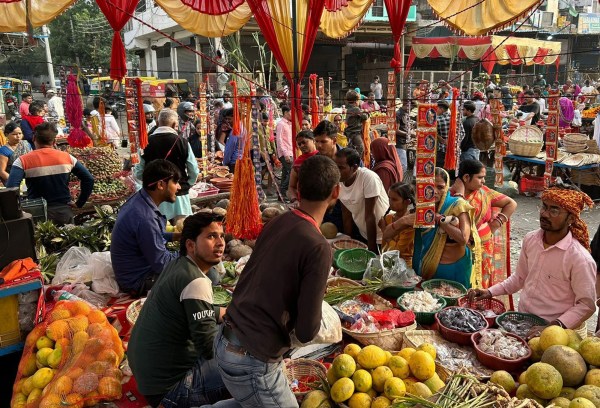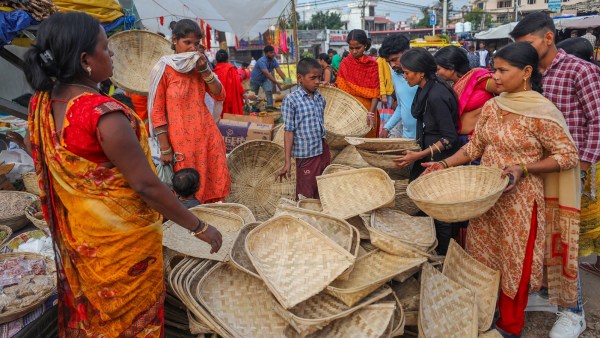President Droupadi Murmu and Prime Minister Narendra Modi led political leaders in wishing people for Chhath Puja on Sunday (November 19).
November 19 is the third day of the Chhath festival this year, which will conclude a day later. While Chhath has been celebrated in Bihar, parts of eastern Uttar Pradesh and Nepal for centuries, over the past decade or so, it has become a lot more visible across the country. Every year, TV channels flash visuals of Chhath being celebrated on the banks of the Thames or the Pacific ocean too.
What is Chhath puja and why is it celebrated? Which deity is Chhathi mother? What is it about Chhath that makes it so close to the Bihari heart?
Beliefs behind why Chhath is celebrated
Chhath Puja is a four-day elaborate celebration in honour of the Sun, which involves a long fast without water, and making offerings to Usha and Pratyusha, the light of the rising and the setting Sun, while standing in a water body.
Several beliefs are prevalent about why Chhath is observed. Some believe that it is a carryover from the time that man worshipped nature. After Lord Ram and Goddess Sita returned victorious to Ayodhya from Lanka, they are said to have observed a fast and conducted a yagna for the Sun god. In the Mahabharata, when the Pandavas were in exile, Draupadi went to sage Dhaumya for help, who advised her to observe a fast and pray to the Sun, and eventually, all her prayers were answered. In the same epic, Karna also organised an elaborate ceremony in honour of Surya (the Sun), his father.
Today, Chhath is a festival that epitomises religiosity in Bihar, and countless devotees who join their hands as the Sun’s rays spread over them feel the touch of divinity and devotion in a measure little else brings to them.
While only some people observe the fast, the entire community gets involved in making the festival a success — cleaning river banks and the roads leading up to those banks, gathering all the little things needed for the rituals, and preparing thekuasthe prasad for the festival which is now synonymous with Bihari cuisine. There are many reasons that set Chhath apart from other festivals (more on that later).
How Chhath is celebrated
Chhath Puja begins on the sixth day of the Kartik month, generally in October-November. Some people celebrate it in the month of Chaitra also (in April), which is called the Chaiti Chhath.
Chest my mother or Mother Chhathi, Sun’s sister, is considered an exacting but generous deity. While the rules governing the four-day festival are exceedingly strict, immense spiritual gains are said to accrue to whoever observes them all successfully.

The first day of the festival is called now eatwhere those observing it take a meal (khana) only after a ceremonial bath in a river, a pond, or the sea (think). Water brought back from the waterbody is used to make a chulha or a stove, and meals for those observing the fast are prepared on this for the rest of the festival. The meal partaken after the bath consists of a pumpkin carrot. Over the years, those who can’t go to a waterbody have started observing all the rituals at home.
The second day is called kharnaon which the one observing the fast takes only one meal in the evening, of roti and kheer (rice pudding). This is also the day friends and family gather to prepare thekuaswhich are essentially flour cakes with sugar or jaggery fried in ghee. The thekuasalso called khajoorare prepared taking great precautions to make sure they are perfect for the deity. People can have them only after they have been offered to God.
After the roti-kheer meal begins a 36-hour fast, during which devotees don’t even drink water.
On the third day, devotees go to the banks of a water body. Those who can’t, build a temporary pool in their homes. The banks are decorated with jazz, rangoliand sugarcane stalks. All the offerings to the God — seasonal fruits like sweet potato, water chestnuts, pomelo, banana — are placed in soops (cane baskets) along with jazz. As the Sun sets, the person fasting raises the swamp to it as an offering (arghya). Friends and family members of the one fasting pour milk or water on the swamp. This is called the Sanjh’s prayeror the evening offering.

The next day, the same ritual is conducted at dawn, for the rising Sun, called the Bhor ka Arghyaand the community returns home from the riverbanks, grateful for the successful conclusion of a difficult festival and for having taken part in it.
What makes Chhath unique?
There are many reasons that Chhath has such a special place in Purvanchalis’ heart. This festival means the coming together of the community, the legendary Bihari migrants returning home to soak themselves in their culture and homeland once more.
Most Read
People from any caste can observe the festival. There are no priests involved, it is the devotee directly fasting for and praying to a visible, apparent God, who shines on everyone equally. The offerings made to the deity are of seasonal, locally produced and thus easily accessible fruit. A joke in Bihar is that humble produce like pomelo and pumpkin, normally not a hot favourite, finally get their moment during Chhath. Both women and men observe the fast, which is held for God, and not for husband or children (like in Karwa Chauth or Jitiya).
No matter how rich or poor you are, the rules are the same for everyone, and the success of the festival lies in how faithfully you observe the rules, not on what scale you observe them at.
Last, and most important, is the message behind the festival — that everyone is equal in the eyes of God, that nature sustains us and is worth honouring, and that dusk is as important as dawn, because life is cyclical and what sets can, and will, rise again.







